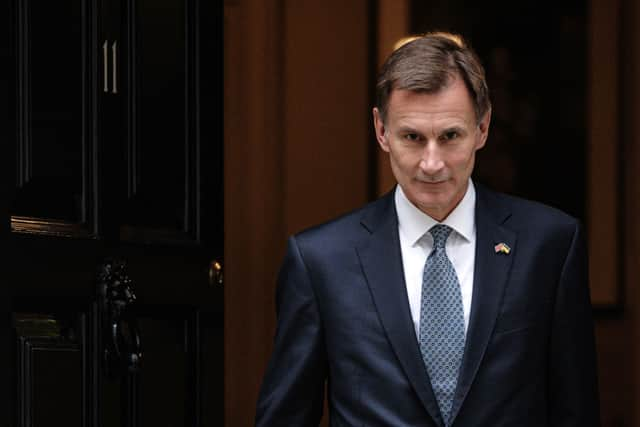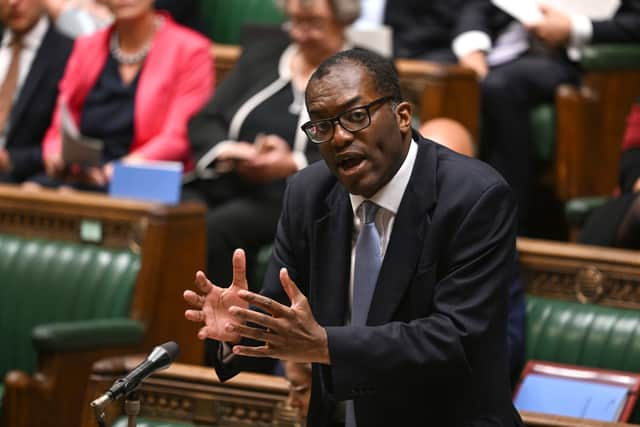Income tax rates: Autumn budget 2022 changes explained - who pays 45p rate, when do new bands take effect?
and live on Freeview channel 276
The Chancellor of the Exchequer Jeremy Hunt delivered the autumn statement on Thursday (17 November).
Outlining a series of tax and spend commitments the government will enact over the coming months, it included plans intended to ease the cost of living crisis, high interest rates and the recession the UK is set to fall into. Hunt said his speech underlined the Rishi Sunak administration’s commitment to “stability, growth and public services”.
Advertisement
Hide AdAdvertisement
Hide AdOne of the key measures the Chancellor announced as part of his plan to give the UK economy stability (or, in other words, fill a £55 billion black hole in the UK’s balance sheet), was a change to the threshold for the 45p rate of income tax.
The change comes after previous Chancellor Kwasi Kwarteng announced he would be scrapping the tax band altogether in his disastrous mini budget. Kwarteng and his boss, Liz Truss, hoped the measure would form a key part of their trickle down economics agenda but were soon forced into a humiliating u-turn that ultimately led to the collapse of the Truss government.
So, what is the 45p rate of income tax - and how’s it changing? Here’s everything you need to know.


What is income tax?
Income tax is a tax every working person in the UK earning money above a certain limit over 12 months pays on their salary. But what you pay depends on how much you earn.
Advertisement
Hide AdAdvertisement
Hide AdFor most workers, anything they earn over a personal allowance of £12,570 is taxable under income tax. In England, Wales and Northern Ireland, income tax is split into these bands:
- Up to £12,570 = 0%
- Between £12,571 to £50,270 = 20%
- From £50,271 to £150,000 = 40%
- Over £150,000 - 45%
The 20% rate had been due to be lowered to 19% from April 2023. This 1p cut to the basic rate would have meant around 31 million people would have been better off by an average of £170 per year, according to the government. But these plans were shelved by Jeremy Hunt when he became Chancellor.
The bands are different in Scotland, which has a starter rate of 19% (for incomes between £12,571 and £14,732) and an intermediate rate of 21% (for those earning £25,689 to £43,662). Its higher rate (above £43,663) is 41% and its top rate (£150,000+) is 46%.
In all the UK nations, those who earn above £125,140 do not get a personal allowance. It means all of their income is exposed to the taxman.
Advertisement
Hide AdAdvertisement
Hide AdThe top rate of income tax is known as the 45p rate because everyone in this top band pays 45p to the Treasury for every £1 they earn over £150,000. According to the OBR, the tax was estimated to have generated £213.2 billion in the 2021/22 financial year, which is almost a quarter (24.7%) of the Treasury’s income from taxes.
How is income tax 45p rate changing?
In his autumn statement on 17 November, Jeremy Hunt announced the 45p income tax rate would have its threshold cut. In effect, it means more people will be paying the tax, thus raising more money for the Treasury.
Those earning £125,140 a year will now also be forced to pay the higher rate. At present, we do not know when this change will come into force.
Who pays the 45p income tax rate?
The existing top rate of income tax is paid by around 600,000 people in England, Wales and Northern Ireland - just 1.2% of the working population.
Advertisement
Hide AdAdvertisement
Hide AdNationalWorld analysis of HMRC data has shown 36.1% of England’s highest earners live in London, while a further 24.5% are based in the South East. London is where many of the UK’s biggest businesses are headquartered and is also one of the world’s largest financial centres.
The North East of England boasts just 1.4% of the UK’s most salaried individuals, while the Yorkshire and Humber region has only 4% of the total. It means the cut to the top rate of income tax would have disproportionately benefited the south of England over the north.
In Scotland, just 0.7% of the population (some 31,000 people) earn more than £150,000. In Wales, 9,000 individuals (0.2%) earn this amount and in Northern Ireland, the figure is 6,000 (0.3%).
Why did Kwasi Kwarteng U-turn on 45p rate?
When announcing he would abolish the top rate of income tax during his 23 September mini budget, the then-Chancellor Kwasi Kwarteng said it would encourage economic growth as it would attract higher earners to the UK. This argument exemplified the trickle down economics both he and Liz Truss were strong advocates of.
Advertisement
Hide AdAdvertisement
Hide AdThe changes meant that from April 2023, there would only be a 40% top rate of tax. “This will simplify the tax system and make Britain more competitive,” Mr Kwarteng said at the time.


Part of the justification Mr Kwarteng gave was that the UK’s 45p income tax rate was the highest percentage tax rate in an income tax top band among the G7 group of nations.
However, Mr Kwarteng was forced to U-turn on on 3 October. The cut to the top rate had sparked political outrage across the political spectrum because it stood to disproportionately benefit the UK’s wealthiest people at the same time as the Chancellor was clamping down on benefits.
Not only did big-name Conservative MPs like Michael Gove and Grant Shapps suggest they would not vote for the measure in Parliament, but the International Monetary Fund (IMF) urged a U-turn, singling the policy out for criticism as it said it would “likely increase inequality”.


Advertisement
Hide AdAdvertisement
Hide AdWhile it was the politics of the announcement that was doing the most damage to the government, it was also one of the many tax cuts that spooked the markets in the immediate aftermath of the mini budget - something which crashed the value of the pound. Several leading economists told NationalWorld that the swathe of tax cuts announced without an independent OBR assessment were “economically dangerous”.
The scrapping of the top rate stood to reduce tax receipts generated for the public purse by around £2 billion. While this figure only accounted for a small proportion of the £45 billion in tax cuts, it nonetheless added to the requirement for much higher government borrowing.
Comment Guidelines
National World encourages reader discussion on our stories. User feedback, insights and back-and-forth exchanges add a rich layer of context to reporting. Please review our Community Guidelines before commenting.
